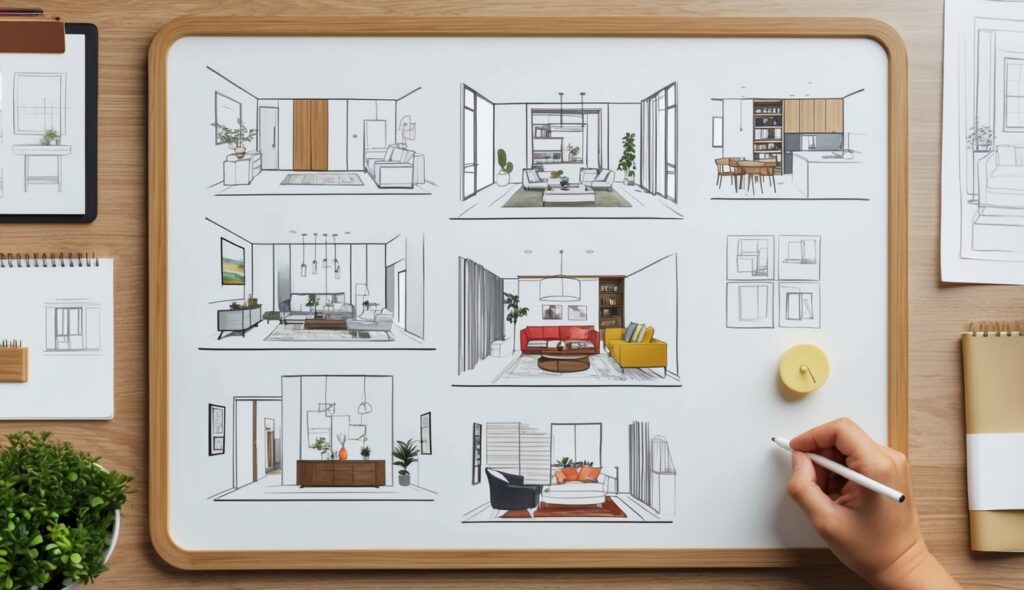The role of paint in architecture goes beyond mere aesthetics.
Remember to repin your favorite images!
Paint samples play a crucial part in maintaining the integrity and historical accuracy of iconic structures.
For example, in Collingwood, VIC, a recent project found that layers of paint revealed hidden histories, offering insights into the building’s original design and subsequent renovations.
These discoveries are not only fascinating but also essential for informed restoration and preservation efforts.
The architectural significance of paint is evident in how it influences design and cultural heritage.
Saturated Space’s study at the Architectural Association delves into the grammar and history of colour, which underscores the value of understanding paint layers.
This knowledge enables architects to recreate authentic interiors and exteriors that reflect the building’s original state, thus preserving its cultural significance.
From a practical standpoint, architectural development heavily relies on these paint samples for both restoration and new builds.
Paint analysis can pinpoint previous architectural features and materials, providing a roadmap for accurate renovation.
This approach ensures that each layer of history is respected and preserved, maintaining the historical architecture that defines iconic structures around the world.
Global Impact of Color in Architecture
Color plays a vital role in the identity of a region, the emotional experience of a space, and the contemporary design of large urban structures. This can be seen in traditional settings and modern innovations around the world.
Color and Cultural Identity
Color reflects cultural values and traditions.
In many parts of the world, specific colors are deeply connected to cultural identity.
In India, vibrant hues are common in traditional architecture. These colors carry symbolic meanings, often tied to festivals and local customs.
In Gothic architecture, darker shades dominate. These colors convey a sense of gravitas and grandeur, matching the form of the era’s towering structures.
Modernist architects like Le Corbusier used colors to redefine spaces. His use of primary colors in volume compositions shaped modern buildings significantly.
Case Studies from India and the Significance of Form
In India, the use of color is not just decorative but also symbolic.
The blue houses of Jodhpur are a prime example. The color blue is said to keep homes cool and repel insects.
Another case is the Pink City of Jaipur. The uniform color scheme creates a cohesive and visually striking urban form.
This choice was made to impress the visiting Prince of Wales in 1876, highlighting the blend of form and cultural significance.
Such practices show how colors can enhance architectural form, tying buildings to cultural and historical contexts in powerful ways.
Modern Skyscrapers and Contemporary Design Trends
Modern skyscrapers use color in innovative ways to stand out.
In contemporary design, subtle hues often convey sophistication and modernity.
For example, many high-rise buildings in cities use glass facades with tinted colors. This not only improves aesthetics but also provides energy efficiency by reducing glare.
Color trends include the use of gradient tones and reflective surfaces.
These choices make large structures more dynamic, reflecting changing light conditions throughout the day.
Detailed Investigation of Design Elements
Attention to design elements such as light, ornamentation, and color is crucial when planning iconic buildings. Each factor has a specific role that can dramatically influence both the functional and aesthetic qualities of a space.
Influence of Light and Technology on Color Perception
Natural light plays a significant role in how colors are perceived in a space.
The angle and intensity of sunlight can alter the appearance of paint, making it essential to test samples under different lighting conditions.
Technology has made this process easier with advances in tools like peel and stick paint samples from services like Samplize.
These allow architects to easily assess how colors will look under varied lighting without the hassle of traditional swatches.
Artificial light also impacts color perception.
LED lighting, for instance, can give warmer or cooler tones based on its settings. Thus, architects need to consider both natural and artificial lighting to bring out the best in a paint job.
Role of Ornamentation and Carvings in Classical Styles
Ornamentation and carvings add depth and character to classical styles.
Such elements include intricate moldings, cornices, and decorative trims that require meticulous paint application.
Detailed investigations often reveal the original materials and techniques used, which are critical for accurate restorations.
Restorative efforts often involve historic paint color analysis to match the original hues and finishes.
This ensures that any renovation maintains the integrity of the building’s design, honoring its historical significance while adding modern function.
Relevance of Color in Functional and Aesthetically Pleasing Spaces
The choice of color in architecture transcends mere aesthetics; it serves functional purposes as well.
For instance, cooler colors can create a calming environment in healthcare settings, while warmer shades might encourage productivity in offices.
Paint can also affect the perceived size and shape of a room, making small spaces feel larger or grand areas cozier.
Architects often conduct a materials analysis to ensure the selected paint is compatible with existing surfaces.
This comprehensive approach guarantees that the new coatings blend seamlessly with older finishes, preserving both the functionality and beauty of the space.

